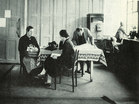
Unternavigation
The proportion of men and women dependent on welfare fell considerably from 1960 onwards. This was a result of the introduction of old age and survivors’ insurance (1948) and disability insurance (1960) – not to mention full employment and wage growth during the postwar boom. The burden faced by communal welfare offices in particular was greatly reduced. At the same time, social workers increasingly encountered difficult social situations. Poverty in welfare society of abundance society was often interpreted as a sign of individual adaptation difficulties.
By the mid-1970s, most cantons had revised their poor relief laws, some of which dated back to the 19th century. To some extent, the new laws reflected the method of social casework developed in the USA. According to this method, individual case investigations, the preparation of tailored support plans and the promotion of independence took the place of control and disciplinary measures. From this point on, the language of social work shifted towards ‘clients’ and ‘consultations’. Simultaneously, the number of placements in labor institutions dropped substantially, while cash support replaced payment in kind. Welfare benefits now sought to guarantee a social subsistence level which also included expenses for cultural activities and a modest daily allowance.
Literatur / Bibliographie / Bibliografia / References: Matter Sonja (2011), Der Armut auf den Leib rücken: Die Professionalisierung der Sozialen Arbeit in der Schweiz (1900–1960), Zürich; Tabin Jean-Pierre et al. (2010 [2008]), Temps d’assistance. L’assistance publique en Suisse romande de la fin du XIXe siècle à nos jours, Lausanne; Sutter Gaby (2007), Vom Polizisten zum Fürsorger: Etablierung und Entwicklung der professionellen Fürsorge in der Gemeinde Bern 1915–1961, Berner Zeitschrift für Geschichte und Heimatkunde, 69, 259–287.
(12/2014)




